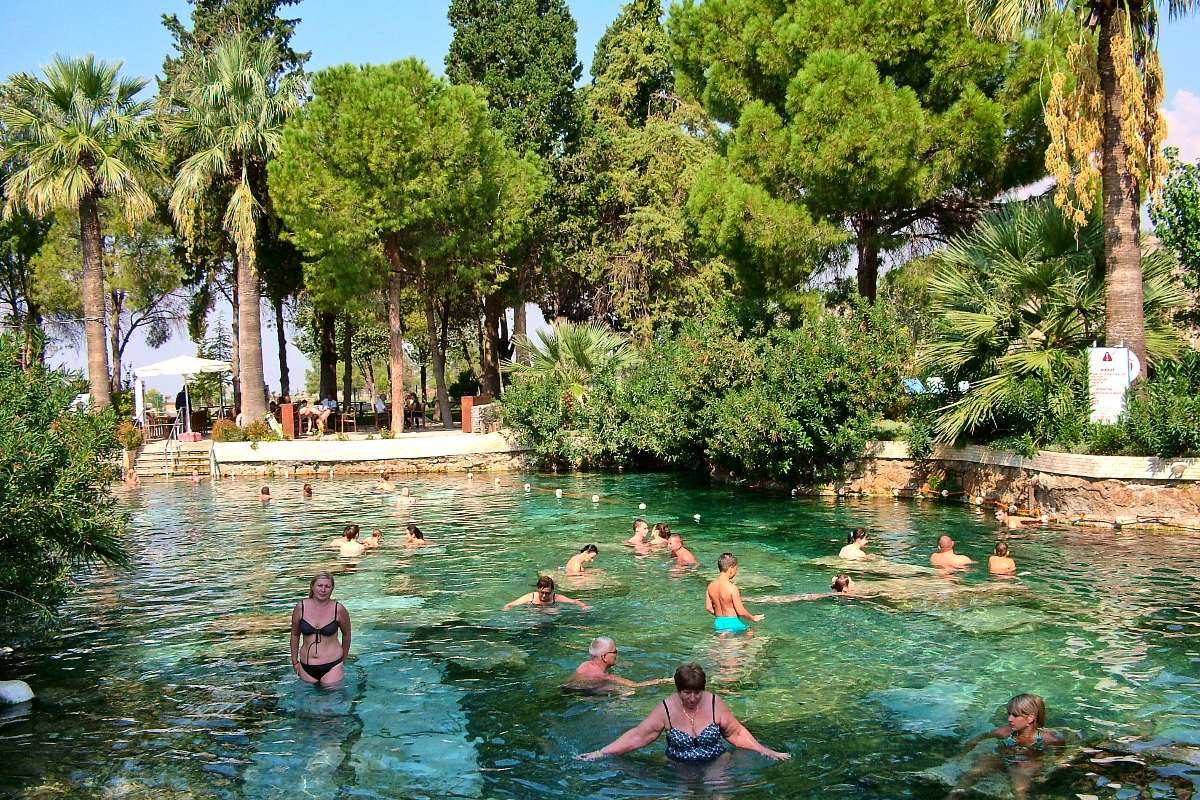Few spas have the history and evocative the history and evocative power of Cleopatra’s Pool in Hierapolis.
While it seems highly unlikely that the famous Egyptian pharaoh visited these baths in person, its name serves as a hook to make mention of another very real aspect: the thermal waters that arise from here were known and exploited in ancient times, especially in times of Roman domination.
So if you also want to enjoy the pleasure and benefits of a dip in this unique place, take note of this activity that Turquía Exclusiva offers you.
If you are visiting Pamukkale and Hierapolisyou will most likely pass in front of Cleopatra’s Pool, also known as the Cleopatra Antique PoolsThe pool is located inside the archaeological site, but independent of it, so it requires a separate entrance fee that is not included in the general ticket.
However, many are those who decide to add this extra to enter the pool, who consider it a fundamental reason to visit this tourist destination.
The pool is, in itself, a very evocative attraction: although the changing rooms and most of the spaces that make up the enclosure are of modern construction, the same is not true of the bottom of the pool itself: its bottom is marked by… !architectural remains from the 2nd century BC! And they are there, at the bottom of the pool, due to an earthquake in the seventh century AD, which demolished the large marble porticoes that once had these baths associated with the spring.
The ancient Romans were well aware of the healing properties of the springs, and knew how to exploit their benefits in the form of natural hot springs.
This was one of the most prestigious of the whole empire, which is why a whole city was built around it: Hierapolis.for which a whole city was built around it: Hierapolis.
But in addition to its practical and scientific component, there are other elements that provide evocation and magic to this place.
For example, the travertine outcrops located on the other side of the archaeological site: although their small pools have neither the temperature nor the composition of the waters of Cleopatra’s Pool in Hierapolis, they do offer a most suggestive scene.
And on the other hand, the mythical grotto The toxic gases emanating from the cave give us an idea of the subterranean reality of the area and explain why the waters that flow from here do so at a higher temperature than normal.
There has been so much mystery surrounding this grotto that a sort of temple dedicated to Pluto, god of the underworld for the Romans, was built: they called it the Plutonium.
Y sobre él llegó a escribir el filósofo griego Estrabón.
Specifically, the waters that emerge from this spring do so at a temperature of between 35º and 100º Celsius. between 35º and 100º, according to some estimates.according to some estimates, but those that remain for the enjoyment of all the users in the Cleopatra Pool are at 36ºwhich is very pleasant in itself.
Your composition is beneficial to health, which also attracts many travelers.
In particular, it is rich in magnesium and calcium (It is the abundance of the latter mineral that has led, by sedimentation over millions of years, to the formation of the famous white travertine terraces of the site).
For this reason, these waters are suitable for the following treatments dermatological problemsThey are even considered an ally against wrinkles and signs of aging.

The activity is basically a free swim in the thermal waters of this pool, formed on the basis of architectural remains of ancient Hierapolis: marble columns, capitals, plinths and other large blocks.
And all this can be easily glimpsed thanks to the transparency of the pool’s waters.
Although the entrance to the site is open to anyone visiting Hierapolis-Pamukkale, in order to take a dip in the water, a separate ticket is required. a separate ticket is required to take a dip in the water..
Una vez dentro, no hay restricciones horarias, pero hay que tener en cuenta que el recinto de la piscina se cierra en torno a las 17.30 (19.30 en temporada alta de verano).
In addition, around Cleopatra’s Pool there are changing rooms, some cafeterias and picnic and relaxation areas, ideal for relaxing before or after visiting the archaeological site of Hierapolis and the travertine terraces of Pamukkale.
And given the warm temperature of the waters, it is a great activity to do. suitable for any time of the year.
Taking a dip in Cleopatra’s Pool in Hierapolis is an activity within everyone’s reach.
Although tickets can be obtained at the ticket office, it is advisable to organize this bathing well in advance because long lines and crowds can form, especially in the high season.
Therefore, if you entrust us with the organization of this activity, we will take care of arranging everything for your comfort: not only will we buy the tickets so that you do not have to wait in line, but we will also pay attention to other important issues, such as equipment for swimming (we remind you that this pool does not provide towels or other necessary items, which must be brought by each user).
In addition, as it is a Unesco protected area, the quality and sustainability of the thermal waters are carefully controlled, which leads to the establishment of a maximum capacity for the Cleopatra Pool.
And that capacity control is what can lead to long queues or even no access at all at certain times.
Therefore, so that nothing is left to chance and you can enjoy this splashing without any surprises, we suggest that you leave everything in our hands to integrate this activity in your visit to the site of Hierapolis and Pamukkale, at the most appropriate time of the day and avoiding queues and other waste of time.